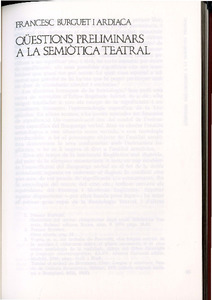Qüestions preliminars a la semiòtica teatral
Metadata
Show full item record
Estudis escènics: quaderns de l'Institut del Teatre. 1984, Núm. 25
Document typeArticle
Abstract
<p>This article tries to shed light, by going over a series of texts, on whether it is possible or legitimate to make a semiotic analysis of the theatre and, at the same time, to delimit the relevance —the nature, so to speak— of the theatrical phenomenon. In the first part of the work —Theatre and Communication— there is an analysis of objections to theatre semiotic based on what may be defined as Panlinguistic Reductionism. This identifies language and communication, tongue and code, in a tautological way and considers double articulation to be essential in order to speak of language (Mounin, <em>La Communication Théatrale, </em>1969). Metz, Eco and above all Ruffini (who defines the concept of Code by taking up Prieto's notions of sematic and noetic fields) expose the contradictions and errors implicit in mechanical, <em>a priori </em>transpositions of linguistic methods and notions to other semiotic fields. Mounin considers the relationship between stage and public to be one of stimulation but not of communication. But this objection stands on an erroneous base, since what is defined as «transposition among codes» really means «transposition between noetic fields with different codes».</p>
<p>The second part —The Object of Theatrical Semiotics: from the Text to the Performance— certifies the theatre’s complexity and code-variety or, as De Marinis says, the multidimensionality and heterogeneity of the theatrical phenomenon or again, as Marthes says, the theatre’s “informational polyphony”. Various works are analysed which, starting from the above-mentioned panlinguistic reductionism, reduce the semiotic analysis of the theatre to an analysis of the written text: Ingarden (who reduces the essence of the theater to the whitten text), Jansen (who considers the text as an invariant and the performance as a variant), Pagnini (who gives to the text the stature of profound structure and to the performance that of superficial structure), Gullí-Pugliatti (who considers the written text to be a metatext that describes the performance). After defending the relevance of the performance, a semiotics of transdisciplinary theater capable of avoiding panlinguistic reductionism is proposed.</p>
Access conditionsOpen Access
ISSN2385-362X
,
0212-3819
Collections
- 1984: Núm.: 25 [6]


